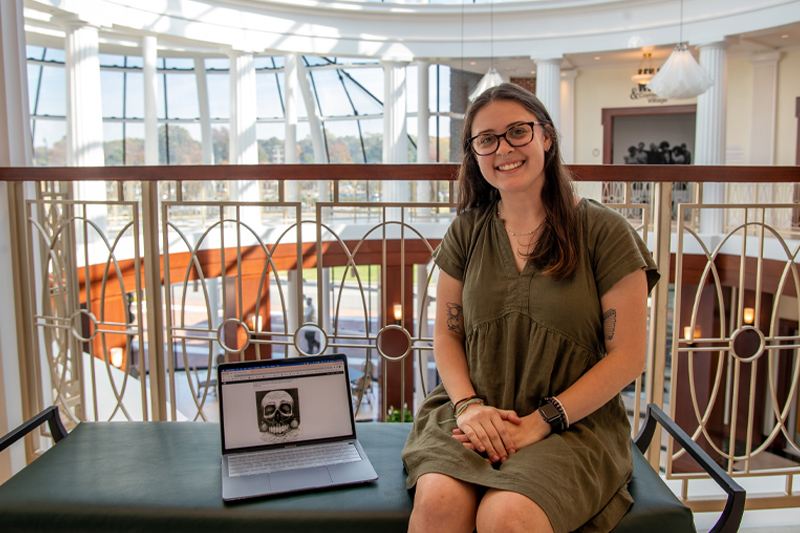
Read time:
A Christopher Newport student has reached deep into America’s medicine cabinet and discovered compelling history in old pills and elixirs.
Brooke Patten, ‘24 History, combined her fascination with medicine with her passion for history and created an online museum exhibit with her professor that is being viewed worldwide.
Patten curated “A Spoonful of Opium Helps the Medicine Sell Faster: The Origins of American Pharmaceuticals and Patent Medicines.” The project was conducted as part of CNU’s Public History Center and is viewable on the Center’s Explore History website.
The exhibit examines the history of medicine, including the trend in the nineteenth century when U.S. manufacturers produced their own over-the-counter medicines, which often included opium, cocaine and nightshade, but didn’t fully disclose the potent and often deadly ingredients to consumers.
Developing all aspects of the exhibit both challenged Patten and brought into focus career possibilities.
“Being almost done with my college experience, this exhibit seemed daunting at the beginning - but seeing the final product made me really proud of how much I have learned and am able to produce as a future historian,” Patten said.
The idea for the exhibit was born out of a service-learning assignment in Public History, a course Patten took with Dr. Sheri Shuck-Hall. Patten selected the topic based on her knowledge and interest in medicine after taking Dr. Sara Black's history course, Disease and the Rise of Modern Medicine.
“I was eager to learn more about what a career in the museum realm may look like, and I found that Shuck-Hall’s class on public history would be the perfect chance. I had no idea I would end up getting such an amazing opportunity,” she said.
Rachel Popp, ‘16 History and curator of the Isle of Wight County Museum, came up with the idea to feature the museum’s collection of medicinal bottles from the 19th and 20th centuries on the Explore History website. Patten visited the museum and walked through its collection of antique medicine bottles and knew exactly how she wanted to focus her exhibit. She then worked with Shuck-Hall and Popp to bring her service-learning project to life. She extensively researched the topic of the evolution of patent medicines, which are medicines sold over the counter.
“Brooke had a fantastic take on this exhibit, which was to not only cover the age of patent medicines, but also to include the colonial period and how medicine and pharmaceuticals evolved,” said Shuck-Hall. “She brought it to the modern-day to link current issues on America’s access to affordable healthcare and why people sometimes seek alternatives, even if they can be dangerous. She uncovered the transition from unregulated pharmaceutical companies and ‘quack medicine’ to the introduction of federal legislation to protect consumers in 1906, ultimately leading to the creation of the Food and Drug Administration (FDA).”
Patten traced how the medicines evolved to how they were used and sometimes abused, to how they are now regulated by the government.
“While I had some previous knowledge in medicine, I was able to learn so many things about American medical history specifically,” Patten said. “The origins of where medicinal ingredients came from and how they would be advertised were super interesting deep dives that I was able to complete during my research.”
Patten started the project in January 2023 and it took about seven months for the exhibit to be ready for online display. She took pictures of the artifacts at the Isle of Wight County Museum with Popp’s assistance and spoke to her about the significance of each object. She worked closely with Shuck-Hall on writing the exhibit and making it both visually interesting and educational.
Popp said: “The contextual portion of every exhibit remains the most important. Curators always try to ask themselves, ‘Why does this matter? Why should people care? How does this still impact us today?’ Brooke did a delightful job of answering these many questions within her exhibit.”
Explore History has proven to be an ideal platform on which to showcase student exhibits such as Patten’s, said Shuck-Hall, who is the creator and editor-in-chief of the website.
“Explore History provides innovative ways to connect the global community with history,” she said. “We create service-learning projects with our community partners, like the Isle of Wight County Museum, featuring artifacts and/or archival collections that have not been seen by a large audience. The great aspect about an exhibit is that it can be shared with anyone across the world unlike an in-person exhibit. In fact, Explore History has viewers as far away as New Zealand. And that is the goal of public history- sharing history with a wide and diverse audience.”
Working on the exhibit, Patten said, has been instrumental in helping her determine her future path.
“I am now so inspired by how virtual exhibits are able to connect the public, and I look forward to potentially replicating this experience in the future,” she said. “After graduation, I am hoping to become an archivist and earn my master’s degree in library and archival science. Having previously been unsure about my future, this experience completely prepared me to explore a potential new career field and earn hands-on experience.”
To learn more about CNU history students working with alumni on PHC virtual exhibits, go to explorehistorycnu.org to view “Machicomoco State Park: A Special Meeting Place” and “Inside the Balloon: A Snapshot of Lee Hall Balloon School at Camp Eustis During World War I.”